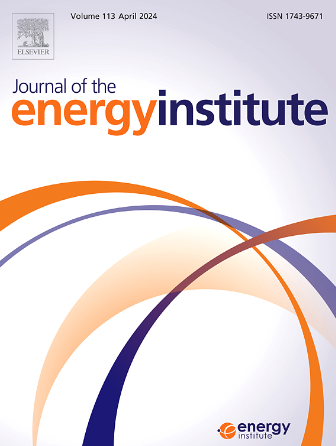The synergistic role of sludge conditioner FeCl3/Rice husk on co-combustion with coal gangue: Thermaldynamic behavior, gases pollutants control and bottom ash stabilization
IF 5.6
2区 工程技术
Q2 ENERGY & FUELS
引用次数: 0
Abstract
Coal processing invariably generates substantial quantities of low calorific value waste, specifically coal gangue (CG), which can be advantageously utilized by combusting to yield valuable electrical energy. However, CG incur poor ignition and flame instability, and consequently is not suited to separate combustion. The co-combustion with sewage sludge (SS) has demonstrated positive impacts on energy recovery, whereas the SS dewatering may significantly influence the co-combustion behavior. Therefore, this study systematically investigated the impact of two typical sludge conditioner, namely FeCl3·6H2O and rice husk (RH), which functions as flocculant and skeletal builder, on their synergistic role on co-combustion with CG. The thermal dynamic combustion behavior, pollutant emissions, slag tendency and bottom ash stability and toxicity were systematically studied. A robust positive synergism is observed, attributed to heat compensation and the formation of alkali metal aluminosilicates from Rh during the ignition phase. Concurrently, the temperature dependent iron oxides evolution enhances the acceleration of O2 loop, thereby promoting the char combustion. After being jointly conditioned with Rh and FeCl3, the co-combustion with CG resulted in CCi being 3.46 times higher than that of C1S3, and the average activation energy in each stage was reduced by 49.1 %. Significantly, the sludge conditioner also contributes to the reduced exhausted gases such as CO2, SO2 and NO. The Rh in SS has been found to mitigate slagging and fouling tendencies, while the retention of Cr, Cu, Ni, and Pb is greatly improved due to the stabilization of silicate minerals in CG. The Artificial Neural Network (ANN) models were established to predict the thermogravimetric experimental data of CG-SS-Rh/Fe, which aims to provide a basis for the selection of optimal operating conditions in real industrial applications.
污泥调节剂FeCl3/稻壳对煤矸石共燃的协同作用:热力学行为、气体污染物控制和底灰稳定
煤炭加工总是会产生大量的低热值废物,特别是煤矸石(CG),可以通过燃烧来有利地利用,产生有价值的电能。然而,CG引起较差的点火和火焰不稳定性,因此不适合分离燃烧。与污泥共燃对能量回收有积极影响,而污泥脱水对共燃行为有显著影响。因此,本研究系统研究了两种典型的污泥调理剂FeCl3·6H2O和稻壳(RH)作为絮凝剂和骨架构建剂,对其与CG共燃协同作用的影响。系统地研究了热动力燃烧行为、污染物排放、渣倾向、底灰稳定性和毒性。一个强大的正协同作用被观察到,归因于热补偿和形成碱金属铝硅酸盐从Rh在点火阶段。同时,温度依赖性铁氧化物的析出增强了O2环的加速,从而促进了炭的燃烧。经Rh和FeCl3共同调节后,与CG共燃烧的CCi比C1S3高3.46倍,各阶段平均活化能降低49.1%。值得注意的是,污泥调理剂还有助于减少排放气体,如CO2, SO2和NO。SS中的Rh可以减轻结渣和结垢的倾向,而由于CG中的硅酸盐矿物的稳定,Cr, Cu, Ni和Pb的保留率大大提高。建立人工神经网络(ANN)模型,对CG-SS-Rh/Fe的热重实验数据进行预测,为实际工业应用中最佳操作条件的选择提供依据。
本文章由计算机程序翻译,如有差异,请以英文原文为准。
求助全文
约1分钟内获得全文
求助全文
来源期刊

Journal of The Energy Institute
工程技术-能源与燃料
CiteScore
10.60
自引率
5.30%
发文量
166
审稿时长
16 days
期刊介绍:
The Journal of the Energy Institute provides peer reviewed coverage of original high quality research on energy, engineering and technology.The coverage is broad and the main areas of interest include:
Combustion engineering and associated technologies; process heating; power generation; engines and propulsion; emissions and environmental pollution control; clean coal technologies; carbon abatement technologies
Emissions and environmental pollution control; safety and hazards;
Clean coal technologies; carbon abatement technologies, including carbon capture and storage, CCS;
Petroleum engineering and fuel quality, including storage and transport
Alternative energy sources; biomass utilisation and biomass conversion technologies; energy from waste, incineration and recycling
Energy conversion, energy recovery and energy efficiency; space heating, fuel cells, heat pumps and cooling systems
Energy storage
The journal''s coverage reflects changes in energy technology that result from the transition to more efficient energy production and end use together with reduced carbon emission.
 求助内容:
求助内容: 应助结果提醒方式:
应助结果提醒方式:


